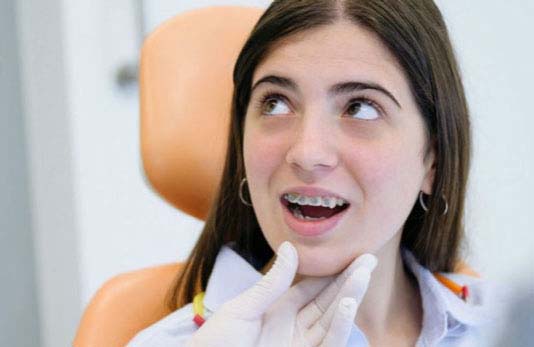What are the risks of wearing alternative braces?

If you’re one of the millions of adults whose teeth need straightening, it’s exciting to know you’re no longer limited to just metal braces. Technology advancements have made more options available for those who may only have mild bite alignment issues, can’t wear braces for two or three years straight or just can’t afford them. Although alternative braces may be more comfortable and less expensive, it’s important to be sure you make the right choice for your dental needs.
What are the different types of alternative braces?
Although alternative braces seem like an easier option, you should be certain which type is the best option for your situation. Here are the most common alternatives to full metal braces.
Invisalign
- What is it? Invisalign involves wearing a series of clear plastic trays on your teeth for 20-22 hours each day. Every couple of weeks, a new set of trays replaces the old set.
- Downsides: Since Invisalign is a removable orthodontic device, it’s generally slower and less effective at fixing complex dental issues. Rather, Invisalign is best for minimal orthodontic needs like bite issues or crooked teeth. If you have crowns or veneers, need complex treatment, or require significant teeth movement consider using traditional braces instead.
Veneers
- What is it? Porcelain veneers work well for patients with gaps, fractured teeth or teeth with poor color, shape or contours. Your dentist removes a thin layer of tooth enamel, and then fixes the veneers to your teeth using light-sensitive resin.
- Downsides: Unlike traditional braces, veneers are a lifetime commitment that require repair or replacement for wear and comfort about every 10 years. Veneers provide a cosmetic fix to aesthetic issues like chips and discoloring. But for teeth arrangement and position, traditional braces may be a better option.
3D braces
- What is it? Yes, you can make your own alternative braces using a 3D printer. No, you shouldn’t do it. At least, not at your home. Some orthodontics have started using software to design and print 3D braces right in their offices. To find out if any physicians are doing this in your area, talk to your orthodontist or get a recommendation from your dentist.
- Downsides: Printing your 3D braces will surely save you time upfront, but professionals are needed to properly fit and make your braces. If you proceed without professional maintenance or supervision, you may end up with misaligned or damaged teeth, not to mention serious injury.
DIY braces
- What is it? DIY braces usually involves fastening common materials like superglue, rubber bands, paper clips and beads to teeth and rigging them to force teeth movement. Before you ask: No, this is not a recommended practice.
- Downsides: Growing in popularity, DIY braces are not an alternative you should try. They can cause enamel damage, lead to gum infection or even loosen your teeth. Metal braces may seem simple, but they are a serious procedure requiring physician supervision to ensure that teeth, gums and bone growth are not damaged in the process.
How can my dentist help me choose the right braces?
Your orthodontist can walk you through your braces options to help you determine the best choice for your situation and lifestyle. Be sure to stay on track with your follow-up visits as well. Regardless of the type of braces you choose, you may deal with some discomfort or jaw pain, so tell your orthodontist if you’re having pain or if things “just don’t feel right.”
Will my insurance cover alternative braces?
Alternative braces generally aren’t covered as part of most insurance plans, so if you decide to go this route, be prepared for some potentially high out-of-pocket costs. Talk with your dentist about financial options before you make any decisions.
Depending on the severity of your issue, traditional braces may be the most effective option. But if your dentist determines that another option may be effective, be sure to follow the plan carefully to ensure that your orthodontic treatment is effective the first time around.
Last updated April 1, 2022
Related articles:
The oral health information on this website is intended for educational purposes only. Always consult a licensed dentist or other qualified health care professional for any questions concerning your oral health.


